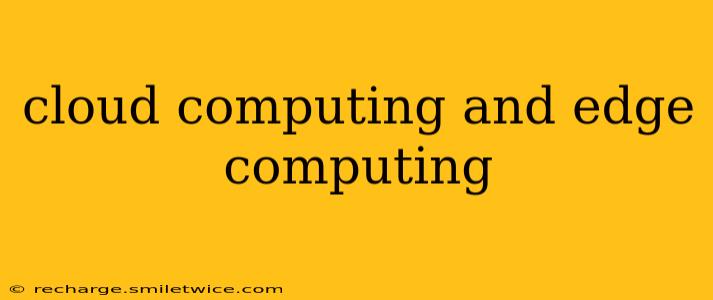The digital world is rapidly evolving, and two key technologies driving this evolution are cloud computing and edge computing. While both offer powerful computing solutions, they differ significantly in their architecture, applications, and benefits. Understanding these differences is crucial for businesses and individuals seeking to leverage the power of modern computing. This comprehensive guide explores the core concepts of cloud and edge computing, compares their strengths and weaknesses, and answers frequently asked questions to help you make informed decisions.
What is Cloud Computing?
Cloud computing refers to the on-demand availability of computer system resources, especially data storage (cloud storage) and computing power, without direct active management by the user. Instead of owning and maintaining physical servers and infrastructure, users access these resources over the internet from a cloud provider like Amazon Web Services (AWS), Microsoft Azure, or Google Cloud Platform (GCP). This model offers scalability, flexibility, and cost-effectiveness, making it ideal for a wide range of applications.
Key Characteristics of Cloud Computing:
- Centralized Data Storage: Data is primarily stored in large data centers managed by the cloud provider.
- High Scalability: Resources can be easily scaled up or down based on demand.
- Cost-Effectiveness: Users pay only for the resources they consume.
- Accessibility: Resources are accessible from anywhere with an internet connection.
What is Edge Computing?
Edge computing, on the other hand, brings computation and data storage closer to the source of data generation. Instead of relying solely on centralized cloud data centers, edge computing processes data at the "edge" of the network—closer to devices like smartphones, IoT sensors, and other endpoints. This reduces latency, improves bandwidth efficiency, and enables real-time processing, critical for applications demanding immediate responses.
Key Characteristics of Edge Computing:
- Decentralized Processing: Data is processed closer to the source, reducing latency.
- Reduced Bandwidth Consumption: Less data needs to be transmitted to the cloud.
- Improved Real-time Capabilities: Enables faster responses and immediate actions.
- Enhanced Security: Data remains closer to the source, potentially minimizing security risks associated with data transmission.
Cloud Computing vs. Edge Computing: A Detailed Comparison
| Feature | Cloud Computing | Edge Computing |
|---|---|---|
| Location | Centralized data centers | Distributed at the network edge |
| Latency | Higher latency due to distance | Lower latency due to proximity to data source |
| Bandwidth | Higher bandwidth consumption | Lower bandwidth consumption |
| Scalability | Highly scalable | Scalability depends on edge deployment |
| Cost | Pay-as-you-go model, potentially lower upfront costs | Higher upfront investment, potentially lower ongoing costs |
| Security | Centralized security, potential single point of failure | Distributed security, potentially more resilient |
| Applications | Web applications, data storage, big data analysis | IoT, autonomous vehicles, real-time video processing |
What are the Benefits of Cloud Computing?
- Cost Savings: Reduced capital expenditure on hardware and infrastructure.
- Scalability and Flexibility: Easily adapt resources to changing needs.
- Increased Efficiency: Automate tasks and improve workflows.
- Enhanced Collaboration: Facilitate teamwork and data sharing.
- Disaster Recovery: Secure data backups and business continuity.
What are the Benefits of Edge Computing?
- Reduced Latency: Faster processing and response times.
- Improved Bandwidth Efficiency: Less data transmitted over the network.
- Enhanced Security: Reduced data exposure and improved privacy.
- Real-time Processing: Enable immediate actions and decisions.
- Offline Functionality: Operate even without internet connectivity.
How Do Cloud and Edge Computing Work Together?
Cloud and edge computing are not mutually exclusive; they often complement each other. A hybrid approach combines the strengths of both. Edge devices can process initial data locally, sending only essential information to the cloud for further analysis and storage. This hybrid model leverages the scalability and storage capacity of the cloud while benefiting from the low latency and real-time capabilities of edge computing.
What are the Limitations of Cloud Computing?
- Internet Dependency: Requires constant internet connectivity.
- Security Concerns: Data breaches and vulnerabilities are potential risks.
- Vendor Lock-in: Switching providers can be complex and costly.
- Latency Issues: Distance from data centers can cause delays.
What are the Limitations of Edge Computing?
- Higher Initial Investment: Requires investment in edge devices and infrastructure.
- Management Complexity: Managing multiple edge devices can be challenging.
- Security Challenges: Securing distributed devices requires robust security measures.
- Limited Storage and Processing Power: Edge devices have limited capabilities compared to cloud data centers.
Conclusion
Both cloud and edge computing offer unique advantages and disadvantages. The best choice depends on the specific application and requirements. For applications requiring low latency and real-time processing, edge computing is often preferred. For applications requiring high scalability, massive data storage, and cost-effectiveness, cloud computing may be the more suitable option. Increasingly, a hybrid approach combining the strengths of both technologies is becoming the most effective solution. By carefully considering these factors, businesses and individuals can leverage the power of both cloud and edge computing to achieve their digital goals.
